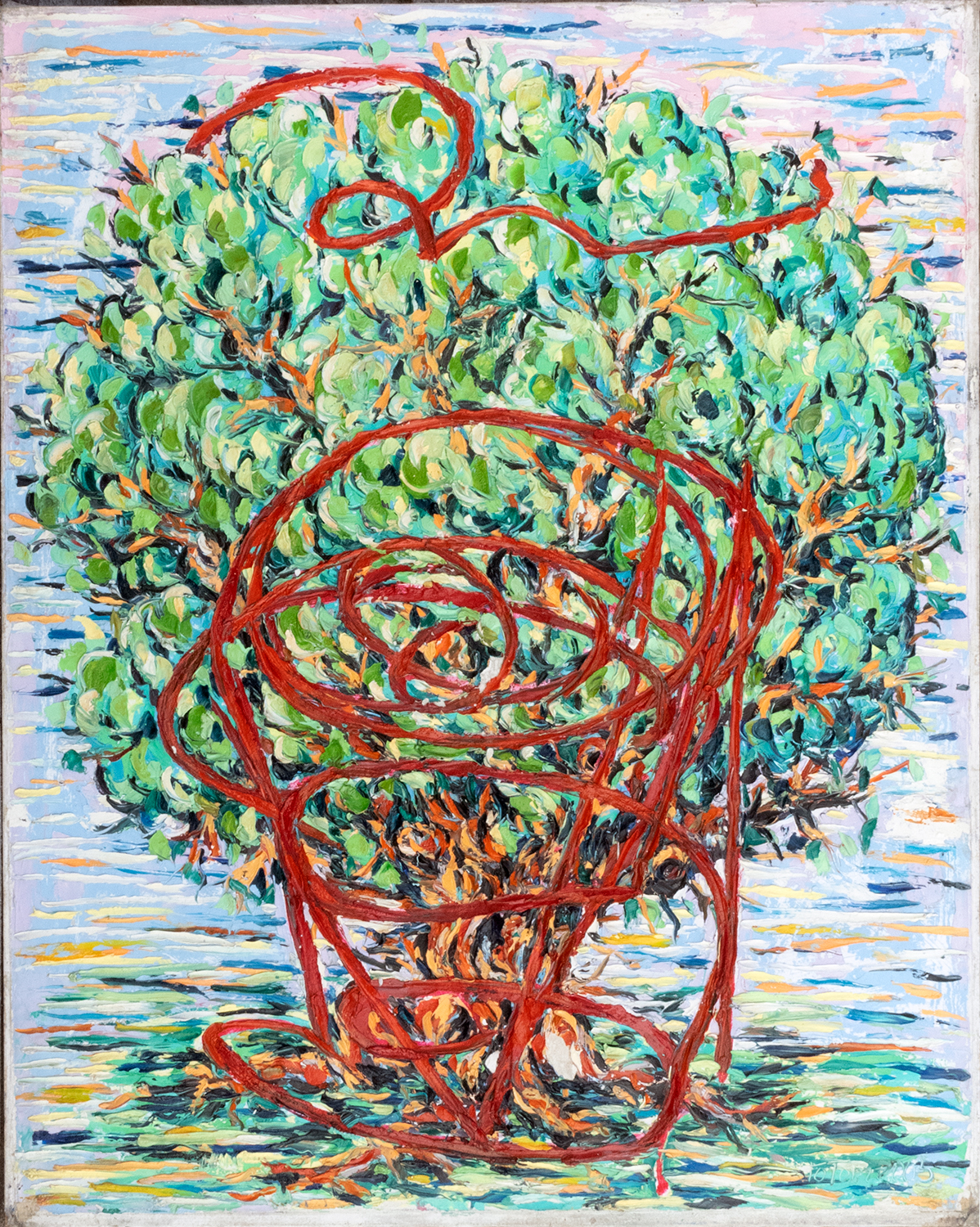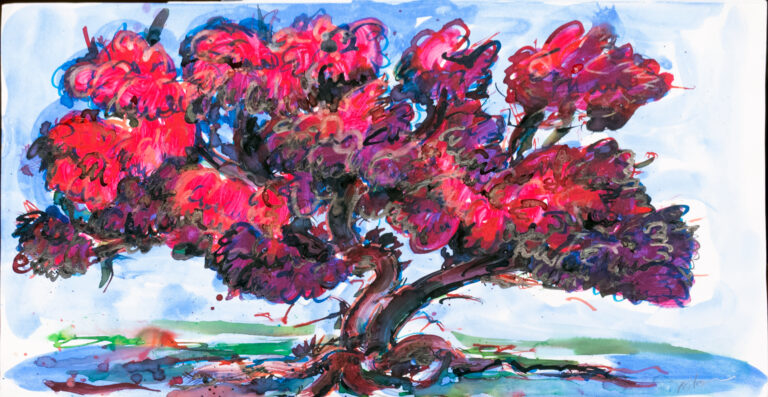Self-portrait of the painter
The painter’s self-portrait portrays the artist, his doubts, his fears, his experiences, how he feels about himself, how he sees himself.
The painters who seek to have a place in the reality that surrounds them, portray themselves or hide in their works, pretending to be one more reality, positioning themselves as part of the world that they try to reflect in their works.
The painters who remain anonymous often identify themselves as witnesses of that reality, they do not consider themselves creators or co-creators of the world they are portraying.
Other painters take self-portraits alone, reflecting a tireless need to find themselves, to love one another, to know themselves.
In the case of Antonio García Calvente, he portrays himself on many occasions, pointing out his need to understand his own creative process and his search for inspiration.
Painter looking at the sky
The painter looking at the sky, is a work by Antonio that reflects the painter’s search for inspiration in the superior, the elevated, the spiritual.
These are two works, separated in time, made one day apart, with a similar color, a similar size, a similar structure, both portray the head of a man looking up. One with a beard, aged, another without a beard, bald.
The first, carried out in June 2026, represents part of the Microcosm work, a search to raise one’s gaze and find in the Macrocosm the answers of the inner world. He is an aged man because he portrays how Antonio felt at that moment, old, experienced, like someone who has been searching for too long and now only has one place left to find the answers he needs.
The other portrait, just the next day, represents the same thing, but with the difference that it lacks hair. On the spiritual path, hair represents pride, personality, disguise, the ego. When a man removes his hair, he removes his pride and humbly embarks on the spiritual path.
This slight correction of the work can be considered an important detail, like a correction, a way of apologizing to heaven or to oneself, for looking and seeking arrogantly upwards.
In this second work, the painter gives up, his effort has led him to understand that he has no chance on his own, and he gives up. He removes his ego, he removes his vanity, he removes his disguise, he no longer seeks answers, he just looks up at the sky.
Self portrait
The self-portrait of the collection that is presented is a large oil work, 97x130cm, with an expressionist style. Made in 2004 and exhibited for the first time in 2005, as we can verify in the authenticity that Antonio signed on the back of the canvas for the exhibition

We can also verify a type of line that is wider than normal, even for a large work, and the tendency of the gaze to the left, the inverse gaze, that Antonio portrayed in so many works, representing that any reality is nothing more than the reflection of another reality. Thus, in the ancient symbology, both artistic and of shields and architecture, everything that looks to the right speaks of the legitimate, the real, the natural, the manifest, and everything that looks to the left speaks of the illegitimate, the false. , the occult, the dream world, the hidden or the secret.
Antonio García Calvente portrays here his dream, his image, his reflection.
Painter and model
In this work Antonio is portrayed with a model
It is an expressionist work where the painter, with a young appearance and an innocent look, paints a picture of a model. The painter doesn’t even look at the painting, or the brush, or the palette, he looks at the model, captivated by her. Maybe scared.
It is an oil on canvas painted on March 28, 2006, 161x163cm.
The model turns her back on the painter, because reality, the experience that the painter tries to portray, turns her back on the curious who tries to know and portray it. Reality is lived, regardless of curious and idle looks.
The painting has no background or context, the figures are suspended in a white and blue bathroom, however the model, portrayed in the painting painted by the painter, is in one place, a temple. It represents that the model, the painter perceives her as a muse, sent from heaven, he considers that she is in a sacred, spiritual place, a place that only he can see.
On the palette, the painter has the colors backwards from how Antonio used to place them. From light to dark from right to left. He shows us again that it is a reflection, not a complete reality, but a representation of something, a dream of something.
Both painter and model are naked. Also something common in Antonio’s works, since the soul, the psyche, is naked. Any item of clothing is nothing more than a costume, and to live something, to experience it, to be it, you have to present yourself without vanity, without arrogance, without disguises.

This work that portrays the painter, or his art, or his life, or his inspiration, once again separates the painter from the center of the painting and portrays the path the artist chooses to reach his creation.
Introspection diptych
The introspection diptych, painted in June 2026, 163x260cm, finished 4 days just before the “Man Looking at the Sky” painting, and 5 before the “Painter Looking at the Sky” painting, represents the painter’s creative search experience to elaborate his creation.

Diptico introspección 163x260cm óleo sobre lienzo
This work portrays the key symbols portrayed by Antonio’s painting: motherhood, the mermaid, the fish, the horse, the turtle, the snail… Here the painter does not hold brushes, but palettes, just as Antonio used.
The painter is portrayed with horns, representing his satyr aspect and his vanity desires, which can drag him down and mislead all art.
Even with all the precious items around him, he is painting a horse, a horse that is nowhere else but in his painting. It represents that what he sees is only within himself.
The direction of gazes are also significant:
The painter, the baby the mermaid and one of the fish look to the left. They are not realities in themselves, they are representations, they are symbols, they are dreams. They belong to the world of the unconscious, they are probabilities, possibilities, movements yet to generate something concrete.
The woman, the snail, the horse, the other fish, the turtle and the snake, look to the right, they are tangible realities, the physical world, of consciousness, of wakefulness, they are concrete and conscious realities of the known world.
The figure of the mother and the baby represents the maternal and feminine aspect of nature, the mountain, the one that holds, guards and embraces the baby, which is a masculine and creative reality yet to be formed, the baby is all that can come to being and none of that at the same time. It is the possibility, the future, the creative force itself. His mischievous look, even mischievous, is that look of someone who already knows that he IS, that he can become anything, that keeps within himself all the strength of the world and when he can he will take it out. It is the look of the wise old man who has nothing to lose.
The mother has a submissive, calm, tired look. She represents who supports, the feminine, the receptive, the mountain that supports all the strength, the earth that embraces and holds us, but at the same time, does not fight, does not threaten.
It is a complete work, an intense and colorful diptych with great meaning.








